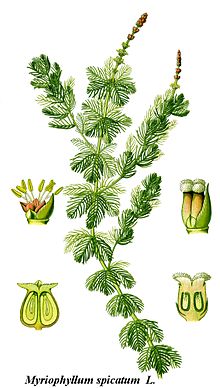Haloragaceae
| Haloragaceae | |
|---|---|
 |
|
| Myriophyllum spicatum | |
| Scientific classification | |
| Kingdom: | Plantae |
| (unranked): | Angiosperms |
| (unranked): | Eudicots |
| (unranked): | Core eudicots |
| Order: | Saxifragales |
| Family: |
Haloragaceae R.Br. |
| genera | |
|
see text |
|
see text
Haloragaceae (the watermilfoil family) is a dicotyledon flowering plant family in the order Saxifragales, based on the phylogenetic APG III system. In the Cronquist system, it was included in the order Haloragales.
The distribution of the family is nearly worldwide. The center of species diversity is in Australia where all genera are found excepting Proserpinaca and Laurembergia. The terrestrial taxa are primarily limited to the southern hemisphere. Glischrocaryon, Haloragodendron, Meionectes and Trihaloragis are Australian endemics.
The family consists mostly of herbaceous perennials or occasionally annuals, although there are some woody taxa (Haloragodendron spp.). Some are primarily terrestrial (Glischrocaryon, Gonocarpus, Haloragis, Haloragodendron and Trihaloragis) while others are primarily semiaquatic (Laurembergia) or aquatic (Meionectes, Myriophyllum and Proserpinaca) of freshwater systems. Myriophyllum are usually monoecious while most other taxa have hermaphrodite flowers. The flowers are usually small and inconspicuous, but some genera can have more "showy" conspicuous flowers (Haloragodendron, Glischrocaryon). Flowers are usually radial (2-3)-4 parted, petals are usually keeled or hooded when present. In Myriophyllum female flowers usually lack a perianth. They have (2-)4-8 stamens and an inferior ovary of (2-)4 carpels. In Myriophyllum the fruit is a schizocarp of 1-seeded 'nutlets' other genera can have nuts or drupes that can be winged or inflated.
...
Wikipedia
